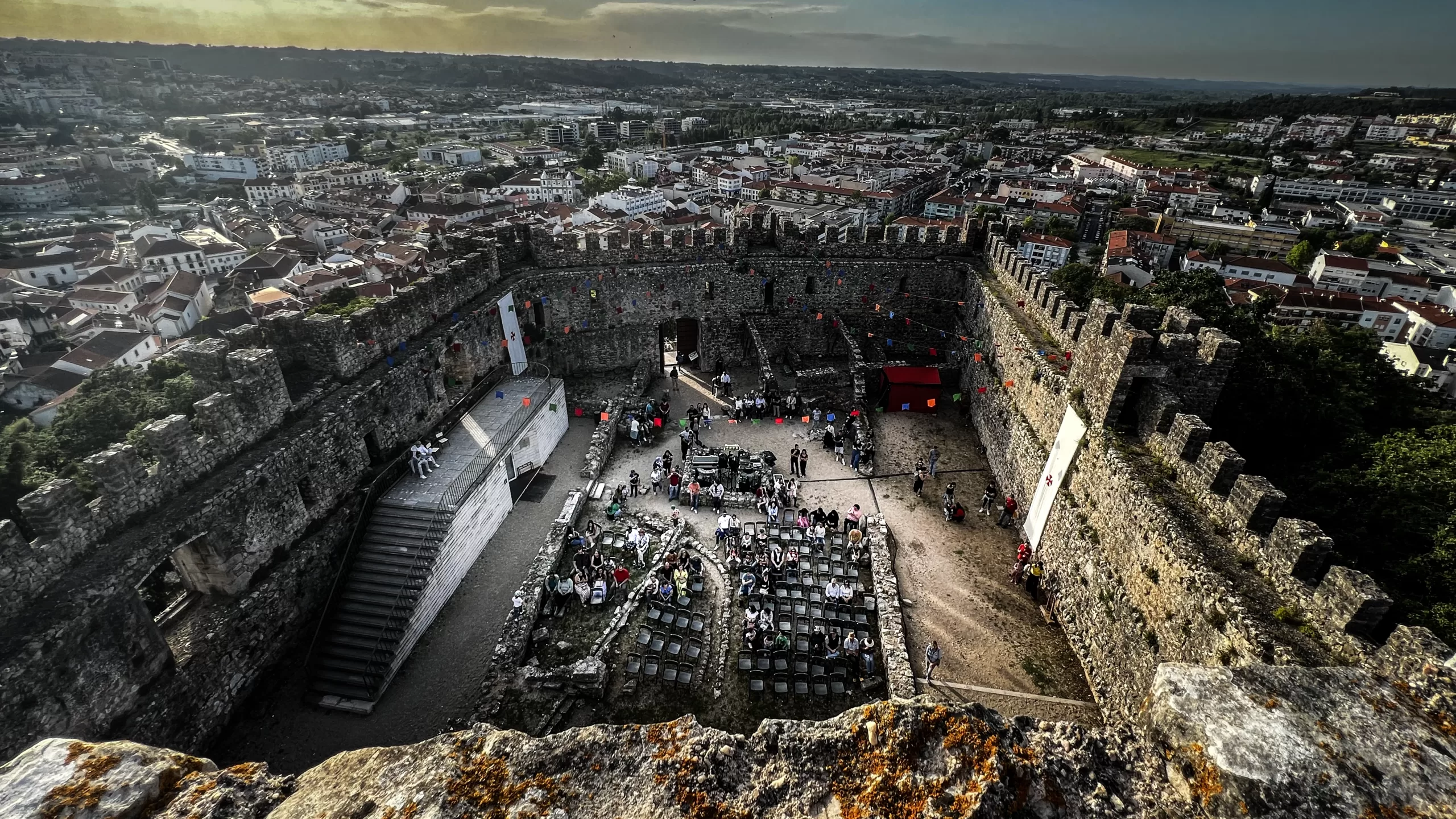If you have been to Coimbra recently, you have seen many decorations. You may wonder what is going on. What are they doing, and why is there a celebration. If you already know this is the Festival for Rainha Santa Isabel.
Often Rainha Santa Isabel is refered to as the “Holy Queen”, Queen Elizabeth, the Patron Saint of Portugal. The names change depending upon which historian you are talking. So as I discuss Rainha Santa Isabel I may change the name. Therefore know these names are for the same person.
July 4, 2022, Coimbra will celebrate Rainha Santa Isabel. In this article, we will discuss how to celebrate and why. First, we will discuss the celebration. Then we will provide more details about who native English speakers know as Saint Elizabeth.

Rainha Santa Isabel (Holy Queen)
Where? Town center
When? Every two years (in even-numbered years)
If you’ve visited Coimbra before, you probably already know that every two years in July, the city stops to honor its patron, Queen Isabel.
However, if this is your first adventure in the city, prepare to witness one of the country’s most beautiful religious festivals. The locals dedication has been worshiping the Holy Queen for hundreds of years.
The procession that honors the Holy Queen happens every two years. You can mingle with other tourists and locals in the city center or see part of the parade from a privileged location: Hotel Oslo’s terrace or Hotel Mondego’s Rooftop.

Who was Rainha Santa Isabel?
Rainha Santa Isabel (1271 – July 4, 1336) was the queen consort of Portugal, wife of King D. Dinis, and a saint of the Roman Catholic Church.
Saint Elizabeth was a descendant of the most influential European families. She was the daughter of King Peter III of Aragon and Queen Constance.
Rainha Santa Isabel was the maternal granddaughter of Manfred of Hohenstaufen, conqueror of Sicily. He was the son of German Emperor Frederick II. The location and date of her birth remain murky. However, historians have indicated her birth may have occurred in Saragoza or Barcelona between 1269 and 1271
The Life of Rainha Santa Isabel
Elizabeth showed an early willingness to serve the Christian Church. She prayed the Divine Office Prayers daily and fasted. She also attended twice-daily choral mass.
Her parents contracted the marriage to King Dinis of Portugal in 1281. She was under ten years of age. As part of her dowry, she received the towns of Óbidos, Abrantes, and Porto de Mós.
The celebration of her marriage occurred in 1288. Dinis was 26 years old, while Elizabeth was 17. Dinis, statesman, and poet, was known as the Rei Lavrador or, in English, The Farmer King. The nickname was because he planted a large pine forest near Leiria to prevent the soil degradation threatening the region.
Elizabeth peacefully sought the traditional religious conventions of her maidenhood. Her devotion was to the sick and poor. Unpretentious in her life values caused ill-will in some of the Nobel quarters.
A famous story told in the streets of Coimbra is how an evil-speaking page aroused her husband’s jealousy. He reprimanded the Queen’s presumed guilty accomplice to a brutal death. D. Dinis was persuaded of her innocence by the strange, unexpected substitution of her accuser for the intended target.
Elizabeth accepted an active curiosity in Portuguese politics. She was an assertive conciliator during the negotiations regarding the Treaty of Alcanizes.
Treaty of Alcanizes
Dinis and Sancho IV of Castile signed the treaty in 1297. It designated the borders separating the two countries. In 1304, the Queen and Dinis returned to Spain to facilitate negotiations between Fernando IV of Castile and James II of Aragon, Elizabeth’s brother.

Rainha Santa Isabela and D. Dinis raised two children:
- A son named Afonso later became King Afonso IV of Portugal and a daughter named Constance. She later married King Ferdinand IV of Castile.
Elizabeth would serve as an arbitrator between her husband and Afonso during the Civil War between 1322 and 1324. The Infante intensely resented the King, whom he blamed for preferring the King’s unlawful son, Afonso Sanches.
The Queen, Rainha Santa Isabel, prevented Dinis of Portugal from killing his son. As legend maintains, in 1323, Elizabeth, mounted on a mule, positioned herself between opposing armies on the field of Alvalade to prevent combat. Peace returned in 1324 and sent the illegitimate son into exile, and the Infante swore loyalty to the King.
The Death of Dinis
After Dinis died in 1325, Elizabeth withdrew to the convent of the Poor Clares. Now it is known as the Monastery of Santa Clara-a-Velha. In 1314, she founded the convent in Coimbra.
Rainha Santa Isabela joined the Franciscan Order, dedicating the rest of her life to the poor and sick in obscurity. During the great famine in 1293, she contributed flour from her cellars to the starving in Coimbra. She was also known for allocating small gifts, disbursing impoverished girls’ dowries, and educating poor nobles’ children. She was a benefactor of various hospitals in Coimbra, Santarém, and Leira.
Rainha Santa Isabel’s Religous Conquests
The religious projects such as the Trinity Convent in Lisbon, chapels in Leira and Óbidos, and the cluster in Alcobaça are reminders of her presence in Portugal.
She functioned as a peacemaker in 1336. Earlier, Afonso IV marched his troops against King Alfonso XI of Castile, who had disregarded Afonso IV’s daughter. Keep in mind Afonso IV had his daughter married to Alfonso XI.
Despite age and weakness, the Queen-dowager insisted on hurrying to Estremoz, where the two kings’ armies assembled. She again stopped the fighting and compelled terms of peace. However, the exertion brought on her final illness. Shortly after her peacetime mission, she died of a fever on July 4, 1336, in the castle of Estremoz.
Rainha Santa Isabel’s Husband’s Death
Although Dinis’ tomb is in Odivelas, Elizabeth was buried in the Monastery of Santa Clara-a-Velha. The monastery in Coimbra provided her resting place with a majestic Gothic sarcophagus.
After recurring flooding by the Mondego River in the 17th century, the Poor Clares repositioned her remains up the hill to the Monastery of Santa Clara-a-Nova. Isabel’s body was moved to the main chapel and buried in a sarcophagus of silver and crystal.

What Miracles did Rainha Santa Isabel Perform?
Legend states she would leave the palace disguised to take food to the poor. Therefore, she was very devoted to God and spent a significant part of her time praying. One of the miracles accredited to her is the “miracle of the roses.”
Miracle of Roses
After the King had discovered she was feeding the poor, she left the palace. He previously forbade her from continuing to provide them with food. He had even threatened to lock her up in the castle’s confines.
She never gave up as she daily left behind the King’s back. One day in the winter, she was carrying pieces of bread in her dress. The King saw her and asked, “What you are carrying?” as she was leaving the castle. She answered, “Roses, my lord.” He did not believe it because roses do not flower in winter.
He requested her to display the roses. Obediently she opened up the fabric of her dress. There stood roses instead of bread. Therefore, this story is the most notable miracle accredited to her.
Devotion to God
Her devotion to the good of God is a teaching of how we should live our lives. However, I am not the most religious of people. However, her inspiration continually moves me through her works with the poor.

When her husband, Dinis, died in 1325, she entered a convent of Poor Claires in Coimbra, where she spent the rest of her life. She left the convent once in the summer of 1336 to try to stop a war between her son, Alphonse IV of Portugal, and her grandson, Alphonse XI of Spain. Despite being sick, she walked to the middle of the battlefield. She did not leave until the two men came to a resolution peacefully. Elizabeth died shortly after.
However, statements of miracles followed upon her death. The Roman Catholic Church beatified her in 1526. Pope Urban VIII canonized her on May 25, 1625.
The Rainha Santo Isabel feast became an essential day on the Roman Catholic Calendar of Saints on July 4. In 1694 Pope Innocent XII moved her feast to July 8, so it would not clash with the celebration of the Octave of Saints Peter and Paul, Apostles. In 1955, Pope Pius XII rescinded this octave. The 1962 Roman Missal revised the status of the feast from “Double” to a “Third-Class Feast.” The 1969 reform of the Calendar organized the celebration as an optional memorial and restored it to July 4.













You must be logged in to post a comment.